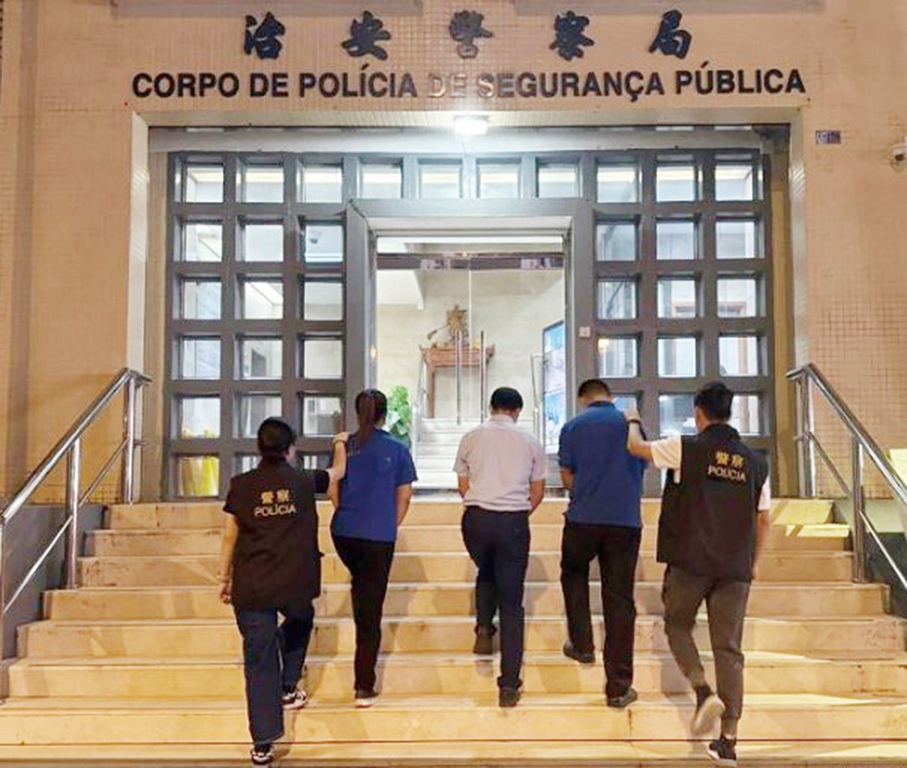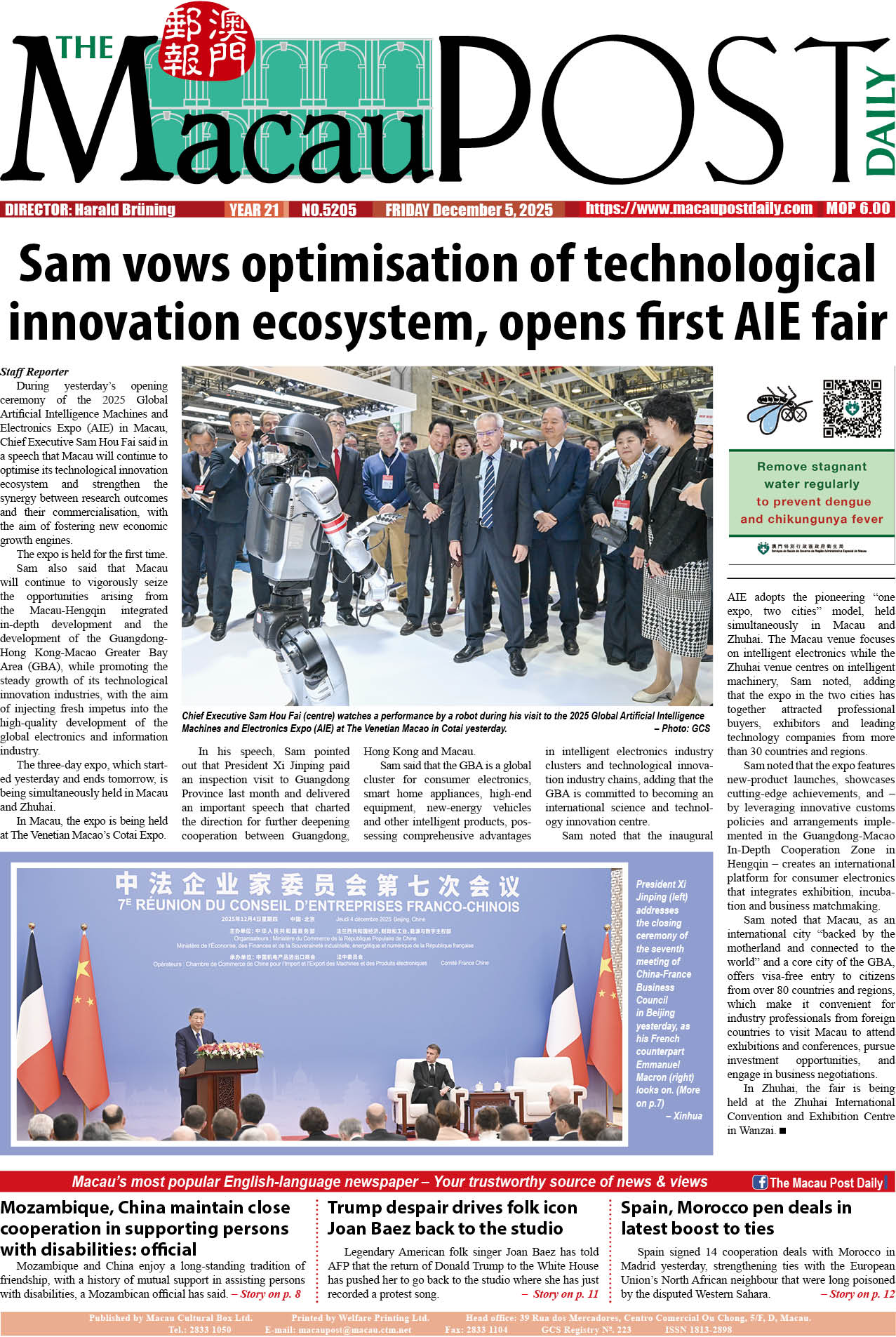Addressing yesterday’s press conference about Macau’s novel coronavirus situation, Health Bureau (SSM) Director Alvis Lo Iek Long announced that the government has come up with an “improved” plan for the possible launch of another mass nucleic acid testing (NAT) drive, such as the increase in the number of testing stations, with some of them to be allocated for certain groups of people such as senior citizens and pregnant women, and the setting-up of backup systems in case of the possible malfunctioning of the Macau Health Code system and the booking system for citywide testing.
While over half of the testing stations under a mass testing programme will be designated for a free test the result of which cannot be used for crossing the Macau-mainland border, some of them will be earmarked for a paid test the result of which can be used for travelling between Macau and the mainland.
According to the plan announced yesterday, the government will release real-time information every 15 minutes about the expected waiting time at the various testing stations.
Lo also said that in case Macau needed to launch a new citywide NAT drive, the government plans to complete the testing within three days, the same timing as in the city’s first mass NAT drive early this month.
Lo said that yesterday’s announcement of the plan also aims for residents to submit opinions and suggestions on further possible improvements to the plan.
In addition to Lo, Education and Youth Development Bureau (DSEDJ) Deputy Director Kong Chi Meng also announced more details about the plan during yesterday’s press conference.
Lo pointed out that the government launched a three-day mass NAT drive on August 4 after Macau confirmed a Delta variant four-member family cluster the day before. Lo acknowledged that residents had to wait for a long time to undergo a nucleic acid test at various testing stations on the first day of the citywide NAT drive, because of which, he said, the government had reviewed the situation of long queues after the 72-hour mass testing was completed, with the aim of coming up with improved measures to be implemented in case Macau needed to launch a new round of mass nucleic acid tests in the future.
All of the 614,465 people who took part in the 72-hour citywide NAT drive early this month tested negative for COVID-19. It was Macau’s first citywide disease testing in its history.
Lo said that the mass NAT drive early this month was completed within three days thanks to the joint efforts of various segments of civil society, residents’ cooperation and the hard work and dedication of all frontline workers who participated in the mass testing programme.
The mass COVID-19 testing programme early this month was carried out by the Health Bureau in collaboration with various other public entities and the city’s private testing institutions.
Lo noted that after the first mass NAT drive was completed early this month, the government had held a number of cross-departmental meetings to identify the problems that occurred in the three-day mass testing programme. Lo said that the government has now drafted an improved plan for the possible implementation of a new round of mass nucleic acid tests, after listening to opinions from residents, officials of the related public entities, and members of the private testing institutions.
5 aspects
According to Lo, the improved plan has five major aspects.
First, Lo said, the government will strengthen coordination among all related public entities involved in a mass COVID-19 testing programme. Lo said that the government has set up a working group for the possible implementation of a citywide testing programme, which is headed by Secretary for Social Affairs and Culture Elsie Ao Ieong U. The working group comprises five functional groups, namely a medical group, a registration group, a group tasked with maintaining order at the various testing stations, a logistics group, and a group tasked with the release of information.
The second aspect is about improving the service procedures, Lo said, adding that the government will increase the number of testing stations and swab collection points, allocate some of the testing stations as “caring” stations only for certain groups of people such as senior citizens, and allow residents to choose the methods of swab collection when booking a test.
The third aspect concerns strengthened human resources, Lo said, pointing out that the Health Bureau has recruited 650 medical volunteers from the private sector for a mass NAT drive, while the Education and Youth Development Bureau (DSEDJ) and the Social Welfare Bureau (IAS) have jointly recruited over 2,000 volunteers to carry out various assistance and supportive tasks during a mass testing programme.
The fourth aspect is about improving the booking procedures, Lo said, noting that in addition to allowing residents to choose testing stations and swab collection methods in advance, the government has also set up backup systems in case of the possible malfunctioning of the Macau Health Code system and the mass testing programme booking system.
The fifth aspect, Lo said, is that the government will regularly release real-time information about the various testing stations, such as the expected waiting time for a test. The task will be carried out by officials in the public security portfolio.
The first mass NAT drive early this month was carried out at 42 testing stations across the city, comprising 269 swab collection points.
52 stations, 367 swab collection points
Lo said that in case Macau needed to launch a new round of mass nucleic acid tests, the government will increase the total number of testing stations by 10 to 52 and the total number of swab collection points by 98 to 367. According to Lo, 31 of the 52 testing stations will be designated for a free test – i.e., the result of which cannot be used for crossing the Macau-mainland border, while 14 of them will be earmarked for those who pay for a test so that their NAT negative result will be available within a shorter period of time, which can be used for travelling between Macau and the mainland.
According to Lo, the remaining seven stations will be “caring” stations which are earmarked for those who are unable to make an appointment – i.e., they can undergo a walk-in test.
According to the improved plan, Lo said, those with a yellow Macau Health Code will be allowed to undergo a test at the various testing stations under a mass NAT drive, but those with a red Macau Health Code must undergo their COVID-19 test at the public Conde de São Januário Hospital Centre.
In addition, Lo also said that the government has bought 700,000 oropharyngeal swabs, 700,000 nasopharyngeal swab and test reagents sufficient for one million tests.
Sample collection via an oropharyngeal swab or a nasopharyngeal will be available at all testing stations, according to Lo.
Lo also said that the government has also set up a backup system at the data centre run by the Administration and Civil Service Bureau (SAFP) in case of the possible malfunctioning of the Macau Health Code system, and a backup system at CTM in case of the possible malfunctioning of the mass testing programme booking system. Lo said that in case the two systems encounter problem, their operation can switch to the backup systems in 15 minutes.
Kong underlined that except “caring” NAT stations, people must make an appointment before undergoing a test at the other two types of testing stations, namely “general” NAT stations and “self-paid” NAT stations.
‘Caring’ lanes for 4 groups
According to Kong, the “caring” NAT stations can only be used by four groups of people, namely those aged three or below, those aged 80 or above, pregnant women, and those holding a Disability Assessment Registration Card or those with reduced mobility. But Kong underlined that only those who are really unable to make an appointment can use the “caring” stations.
Kong said that “caring” lanes will be set up at the “general” NAT stations for the four groups of people, suggesting that they can choose to make an appointment for a test at the “general” NAT stations with the assistance of their family members or friends, in which case they can use the “caring” lanes at the “general” NAT stations.
According to Kong, the real-time information about the expected waiting time at the various testing stations will be indicated in three colours, namely green for a waiting time of less than 30 minutes, yellow for a waiting time of between 31 and 59 minutes, and red for a waiting time of at least an hour. The information will be available on the mass testing drive’s booking system.
Health Bureau (SSM) Director Alvis Lo Iek Long (left) speaks during yesterday’s press conference about the city’s novel coronavirus (COVID-19) situation, as Education and Youth Development Bureau (DSEDJ) Deputy Director Kong Chi Meng looks on. Photo: Tony Wong

Residents queue outside the Macau Forum complex in Zape early this month, one of the testing stations under the government’s then three-day mass nucleic acid testing (NAT) drive. Photo: MPDG








